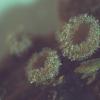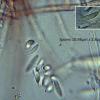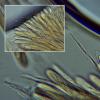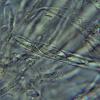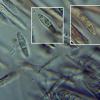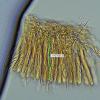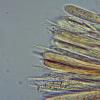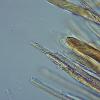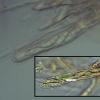
20-12-2025 23:08
Patrice TANCHAUDBonsoir, récolte sur sol sablonneux dans l'arri�

21-12-2025 09:32
Hello.A tiny ascomycete found embedded in wood in

20-12-2025 15:47
Mirek GrycHi.These grew on pine wood that was heavily covere

18-12-2025 21:17
Pol DebaenstThe identification took me to Byssonectria deformi

15-12-2025 07:09
 Danny Newman
Danny Newman
indet. Rutstroemiaceae sp. on unk. fallen leavesMc

19-12-2025 10:10
Patrice TANCHAUDBonjour, récolte réalisée en milieu dunaire, a

18-12-2025 17:23
 Bruno Coué
Bruno Coué
Bonjour,je serais heureux d'avoir votre avis sur c
Trichopezizella barbata possiblity?
Hardware Tony,
05-05-2020 16:12
 Hi, First time here, and in English so hope can translate easily. Found this tiny hairy ascomycete under small twig at side of stream. Noted that the hairs push towards the margin. The spores look good for this species to me but first time seen and worse still, only fourth record in UK if correct. Can anyone cast an eye and experience across what I can provide here. Asci 60µm plus with para. riding above by around 16µm. Spores shown on pic. Spores with single septa, although appears more thann this inside ascus.
Hi, First time here, and in English so hope can translate easily. Found this tiny hairy ascomycete under small twig at side of stream. Noted that the hairs push towards the margin. The spores look good for this species to me but first time seen and worse still, only fourth record in UK if correct. Can anyone cast an eye and experience across what I can provide here. Asci 60µm plus with para. riding above by around 16µm. Spores shown on pic. Spores with single septa, although appears more thann this inside ascus.with many thanks Tony Hardware Cornwall UK (Cornwall Fungus Recording Group)
Peter Thompson,
05-05-2020 17:10
Re : Trichopezizella barbata possiblity?
Hello Tony,
English language is fine on Ascofrance. I always write in English on the site.
We need more information:
Is the host substrate likely to be Lonicera = honeysuckle?
Micro photos of the hairs, particularly their tips, would be very useful. Also, are the hairs on the flanks straight or twisted?
Are the paraphyses lanceolate or rounded at the tips?
Do the tips of the asci react in Lugol = IKI (not Melzers)? If so, what colour is the reaction?
A photo of the cells of the excipulum would be useful.
There are more than four British records in the CATE2 national fungus database alone, though this is a rare species, if you have identified it correctly.
With Best Wishes,
Peter Thompson.
English language is fine on Ascofrance. I always write in English on the site.
We need more information:
Is the host substrate likely to be Lonicera = honeysuckle?
Micro photos of the hairs, particularly their tips, would be very useful. Also, are the hairs on the flanks straight or twisted?
Are the paraphyses lanceolate or rounded at the tips?
Do the tips of the asci react in Lugol = IKI (not Melzers)? If so, what colour is the reaction?
A photo of the cells of the excipulum would be useful.
There are more than four British records in the CATE2 national fungus database alone, though this is a rare species, if you have identified it correctly.
With Best Wishes,
Peter Thompson.
Hans-Otto Baral,
05-05-2020 18:20

Re : Trichopezizella barbata possiblity?
Hello
I would add to the valuable list of Peter the importance of spore contents, you must mount the spores in water, then it will be clear if they are filled with oil drops as in Lasiob. lonicerae which I would suspect or rather empty as in L. variegatum.
Hardware Tony,
05-05-2020 20:32

Re : Trichopezizella barbata possiblity?
Hello Peter/Hans-Otto,
Thank you for your prompt reply. Tried again to see if I had some answers here, inc spores in water showing oil drops, some 4 per spore. Not great but had an issue with oil at 1000x. The substrate was unknown but around Fagus woodland but also where various flowers and shrubs were or had been growing as by open water, so I will need to go back to check for Honeysuckle. The twig I found it on was thornless, featureless, leafless and isolated so could be anything.
Added hair tips here and paras. All at 1000x. The hairs appear straight to me virtually all the way around the margin. The paras seem pointed at the tips so lanceolate perhaps. Not great pics of the tissue but few added here in case helps. The key pattern of the 'fan' didn't appear in the older material I used. Didn't use Lugol as still trying to get some, so back to Melzers. No bluing as you can see.
Many thanks for your input both, been looking at your comments for a couple of years now and great to have been involved in such a responsive forum. Peter: the three other only records were from BMS, so looks like the CATE2 database is ahead of the rest.
Tony Hardware
Thank you for your prompt reply. Tried again to see if I had some answers here, inc spores in water showing oil drops, some 4 per spore. Not great but had an issue with oil at 1000x. The substrate was unknown but around Fagus woodland but also where various flowers and shrubs were or had been growing as by open water, so I will need to go back to check for Honeysuckle. The twig I found it on was thornless, featureless, leafless and isolated so could be anything.
Added hair tips here and paras. All at 1000x. The hairs appear straight to me virtually all the way around the margin. The paras seem pointed at the tips so lanceolate perhaps. Not great pics of the tissue but few added here in case helps. The key pattern of the 'fan' didn't appear in the older material I used. Didn't use Lugol as still trying to get some, so back to Melzers. No bluing as you can see.
Many thanks for your input both, been looking at your comments for a couple of years now and great to have been involved in such a responsive forum. Peter: the three other only records were from BMS, so looks like the CATE2 database is ahead of the rest.
Tony Hardware
Peter Thompson,
05-05-2020 20:54
Re : Trichopezizella barbata possiblity?
Hello Tony,
I think that there is some faint bluing of the ascus tips in Melzers on two of your photos. A negative reaction would be very unusual in the Lachnaceae. Lugol would show a red reaction in some species, including Trichopezizella barbata, but Melzers will not show this.
The reason why I asked about whether there were straight or twisted hairs specifically on the flanks was to determine whether the genus of your sample is Lasiobelonium. Hairs at the margin will be straight in any case, as you say.
I think that both Zotto and I believe that you have a Lasiobelonium - probably L. lonicerae (as Zotto has already suggested.)The 1-septate spores and guttules would be correct for this species.
We will see what Zotto says when he replies.
With Best Wishes,
Peter.
I think that there is some faint bluing of the ascus tips in Melzers on two of your photos. A negative reaction would be very unusual in the Lachnaceae. Lugol would show a red reaction in some species, including Trichopezizella barbata, but Melzers will not show this.
The reason why I asked about whether there were straight or twisted hairs specifically on the flanks was to determine whether the genus of your sample is Lasiobelonium. Hairs at the margin will be straight in any case, as you say.
I think that both Zotto and I believe that you have a Lasiobelonium - probably L. lonicerae (as Zotto has already suggested.)The 1-septate spores and guttules would be correct for this species.
We will see what Zotto says when he replies.
With Best Wishes,
Peter.
Hans-Otto Baral,
05-05-2020 21:26

Re : Trichopezizella barbata possiblity?
Yes, and as I remember L. lonicerae has septate spores inside the living asci. To prove this is perhaps impossible now, as my feeling tells me that the material was dried prior to microscopy. It requires some skillness for vital characters, avoiding much pressure and nevertheless get free asci. Sections would be the best.
L. lonicerae is not host specific, the substrate is angiosperm wood of different kind.
Hardware Tony,
05-05-2020 22:29

Re : Trichopezizella barbata possiblity?
Hi Otto/Peter,
You are correct Otto in that the samples did dry out more than expected and added too much pressure. However, I did take other pics with the original samples and knowing you may need this info then attach this pic showing the sepate appearing along the spore within the ascus.
Many thanks for both your help been much apprecaited. Learnt a lot already and hopefully will be more experineced next time. Still sounds like an unusual find for Cornwall for sure.
Thanks again Tony
PS: Peter - I assume your sign off last time is a German translation for Exit, or something?! :-)
You are correct Otto in that the samples did dry out more than expected and added too much pressure. However, I did take other pics with the original samples and knowing you may need this info then attach this pic showing the sepate appearing along the spore within the ascus.
Many thanks for both your help been much apprecaited. Learnt a lot already and hopefully will be more experineced next time. Still sounds like an unusual find for Cornwall for sure.
Thanks again Tony
PS: Peter - I assume your sign off last time is a German translation for Exit, or something?! :-)
Peter Thompson,
05-05-2020 23:12
Re : Trichopezizella barbata possiblity?
Hello Tony,
I assume you are wondering about "Zotto" as a German word? For those of us who have been using Ascofrance for a while, Zotto = Hans-Otto Baral. Probably the same as you shortening Anthony to Tony, I guess.
There are only six records of Lasiobelonium lonicerae in CATE2, three of which are mine. None from Cornwall, so yours will be the first Cornish record. The FRDBI seems to have been unavailable for some time, so can't check for records there these days.
Microfungi from the ascomycota are rarely studied in Britain, with only a small number of competent mycologists looking at them regularly. Generally, there are 'hot spots' for the 'difficult' ascos in the areas where each of us does fieldwork.
With Best Wishes,
Peter.
I assume you are wondering about "Zotto" as a German word? For those of us who have been using Ascofrance for a while, Zotto = Hans-Otto Baral. Probably the same as you shortening Anthony to Tony, I guess.
There are only six records of Lasiobelonium lonicerae in CATE2, three of which are mine. None from Cornwall, so yours will be the first Cornish record. The FRDBI seems to have been unavailable for some time, so can't check for records there these days.
Microfungi from the ascomycota are rarely studied in Britain, with only a small number of competent mycologists looking at them regularly. Generally, there are 'hot spots' for the 'difficult' ascos in the areas where each of us does fieldwork.
With Best Wishes,
Peter.
Hans-Otto Baral,
06-05-2020 06:59

Re : Trichopezizella barbata possiblity?
Dear Tony
thanks for the additional pic. The constant presence of a septum inside the asci supports the idea of L. lonicerae. However, both asci and spores are dead, so the drops cannot be seen and such septate spores could be overmature. Actually, also L. variegatum gets finally septate spores, either when ejected or inside dead asci from which they will never be ejected. But you will never find septate spores in the living asci of that species. I think you need a new fresh sample to test vital characters.
Your first pic of the second row is very instructive, showing spores with the upper cell alive and the lower dead, the lower much smaller (due to the shrinking effect) and without apparent oil drops.
Zotto

